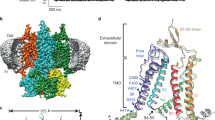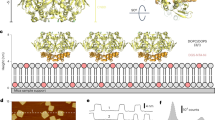Abstract
Despite recent advances in the identification of ligand-binding1,2 and voltage-sensing3 regions of ion channels, the domains that couple such regions to channel opening have not been identified. Moreover, it is uncertain whether ligand binding or depolarization are obligatory steps that must precede channel opening (according to linear reaction schemes4,5) or whether they act to stabilize the channel in an open state that can exist independently of ligand binding or depolarization (according to cyclic allosteric models6–8). By comparing ligand-independent and ligand-dependent channel openings, we now show that retinal and olfactory cyclic-nucleotide-gated channels2 are activated by a cyclic allosteric mechanism. We further show that an amino-terminal domain, distinct from the pore and ligand-binding motifs, participates in the allosteric gating transition, accounting for differences in the free energy of gating of the two channels. The allosteric transition provides an important mechanism for tuning the physiological response of ligand-binding proteins, such as cyclic-nucleotide-gated channels, to different biological signals.
This is a preview of subscription content, access via your institution
Access options
Subscribe to this journal
Receive 51 print issues and online access
$199.00 per year
only $3.90 per issue
Buy this article
- Purchase on Springer Link
- Instant access to full article PDF
Prices may be subject to local taxes which are calculated during checkout
Similar content being viewed by others
References
Karlin, A. & Akabas, M. H. Toward a structural basis for the function of nicotinic acetylcholine receptors and their cousins. Neuron 15, 1231–1244 (1995).
Zagotta, W. N. & Siegelbaum, S. A. Structure and function of cyclic nucleotide-gated channels. Annu. Rev. Neurosd. 19, 235–263 (1996).
Stuhmer, W. et al. Structural parts involved in activation and inactivation of the sodium channel. Nature 339, 597–603 (1989).
Hodgkin, A. L. & Huxley, A. F. A quantitative description of membrane current and its application to conduction and excitation in nerve. J. Physiol. (Lond.) 117, 500–544 (1952).
del Castillo, J. & Katz, B. Interaction at end-plate receptors between different choline derivatives. Proc. R. Soc. Lond. B. 146, 369–381 (1957).
Monod, J., Wyman, J. & Changeaux, J.-P. On the nature of allosteric transitions: a plausible model. J. Mol. Biol. 12, 88–118 (1965).
Jackson, M. B. Spontaneous openings of the acetylcholine receptor channel. Proc. Natl Acad. Sri. USA 81, 3901–3904 (1984).
Picones, A. & Korenbrot, J. I. Spontaneous ligand-independent activity of the cGMP-gated ion channels in cone photoreceptors of fish. J. Physiol. (Lond.) 485, 699–714 (1995).
Goulding, E. H., Tibbs, G. R. & Siegelbaum, S. A. Molecular mechanism of cyclic-nucleotide-gated channel activation. Nature 372, 369–374 (1994).
Varnum, M. D., Black, K. D. & Zagotta, W. N. Molecular mechanism for ligand discrimination of cyclic nucleotide-gated channels. Neuron 15, 619–625 (1995).
Gordon, S. E. & Zagotta, W. N. Localization of regions affecting an allosteric transition in cyclic nucleotide-activated channels. Neuron 14, 857–864 (1995).
Kaupp, U. B. et al. Primary structure and functional expression from complementary DNA of the rod photoreceptor cyclic GMP-gated channel. Nature 342, 762–766 (1989).
Shabb, J. B. & Corbin, J. D. Cyclic nucleotide-binding domains in proteins having diverse functions. J. Biol. Chem. 267, 5723–5726 (1992).
Goulding, E. H. et al. Molecular cloning and single-channel properties of the cyclic nucleotide-gated channel from catfish olfactory neurons. Neuron 8, 45–58 (1992).
Kramer, R. H., Goulding, E. H. & Siegelbaum, S. A. Potassium channel inactivation peptide blocks cyclic nucleotide-gated channels by binding to the conserved pore domain. Neuron 12, 655–662 (1994).
Zagotta, W. N., Hoshi, T. & Aldrich, R. W. Restoration of inactivation in mutants of Shaker potassium channels by a peptide derived from ShB. Science 250, 568–571 (1990).
Murrell-Lagnado, R. D. & Aldrich, R. W. Energetics of Shaker K channels block by inactivation peptides. J. Gen. Physiol. 102, 977–1003 (1993).
Goulding, E. H., Tibbs, G. R., Liu, D. & Siegelbaum, S. A. Role of H5 domain in determining pore diameter and ion permeation through cyclic nucleotide-gated channels. Nature 364, 61–64 (1993).
Weber, I. T. & Steitz, T. A. Structure of a complex of catabolite gene activator protein and cyclic AMP refined at 2.5 Å resolution. J. Mol. Biol. 198, 311–326 (1987).
Bubis, J., Neitzel, J. J., Saraswat, L. D. & Taylor, S. S. A point mutation abolishes binding of cAMP to site A in the regulatory subunit of cAMP-dependent protein kinase. J. Biol. Chem. 263, 9668–9673 (1988).
Stern-Bach, Y. et al. Agonist selectivity of glutamate receptors is specified by two domains structurally related to bacterial amino acid-binding proteins. Neuron 13, 1345–1357 (1994).
Perutz, M. Mechanisms of Cooperativity and Allosteric Regulation in Proteins 10–12 (Cambridge University Press, Cambridge, 1990).
Auerbach, A., Sigurdson, W., Chen, J. & Akk, G. Voltage dependence of mouse acetylcholine receptor gating: Different charge movements in di-, mono- and unliganded receptors. J. Physiol. (Lond.) 494, 155–170 (1996).
Li, M., Jan, Y. N. & Jan, L. Y. Specification of subunit assembly by the hydrophilic amino-terminal domain of the Shaker potassium channel. Science 257, 1225–1230 (1992).
Shen, N. V., Chen, X., Boyer, M. M. & Pfaffinger, P. J. Deletion analysis of K+ channel assembly. Neuron 11, 67–76 (1993).
Babila, T., Moscucci, A., Wang, H., Weaver, F. E. & Koren, G. Assembly of mammalian voltage-gated potassium channels: evidence for an important role of the first transmembrane segment. Neuron 12, 615–626 (1994).
Tu, L. W. et al. Voltage-gated K+ channels contain multiple intersubunit association sites. J. Biol. Chem. 271, 18904–18911 (1996).
Unwin, N. Acetylcholine receptor channel imaged in the open state. Nature 373, 37–43 (1995).
Liu, M., Chen, T. Y., Ahamed, B., Li, J. & Yau, K. W. Calcium-calmodulin modulation of the olfactory cyclic nucleotide-gated cation channel. Science 266, 1348–1354 (1994).
Gordon, S. E., Brautigan, D. L. & Zimmerman, A. L. Protein phosphatases modulate the apparent agonist affinity of the light-regulated ion channel in retinal rods. Neuron 9, 739–748 (1992).
Author information
Authors and Affiliations
Rights and permissions
About this article
Cite this article
Tibbs, G., Goulding, E. & Siegelbaum, S. Allosteric activation and tuning of ligand efficacy in cyclic-nucleotide-gated channels. Nature 386, 612–615 (1997). https://doi.org/10.1038/386612a0
Received:
Accepted:
Issue Date:
DOI: https://doi.org/10.1038/386612a0
This article is cited by
-
Fast functional mapping of ligand-gated ion channels
Communications Biology (2023)
-
The solute carrier SLC9C1 is a Na+/H+-exchanger gated by an S4-type voltage-sensor and cyclic-nucleotide binding
Nature Communications (2018)
-
Deciphering the function of the CNGB1b subunit in olfactory CNG channels
Scientific Reports (2016)
-
Relating ligand binding to activation gating in CNGA2 channels
Nature (2007)
-
High-throughput random mutagenesis screen reveals TRPM8 residues specifically required for activation by menthol
Nature Neuroscience (2006)
Comments
By submitting a comment you agree to abide by our Terms and Community Guidelines. If you find something abusive or that does not comply with our terms or guidelines please flag it as inappropriate.



